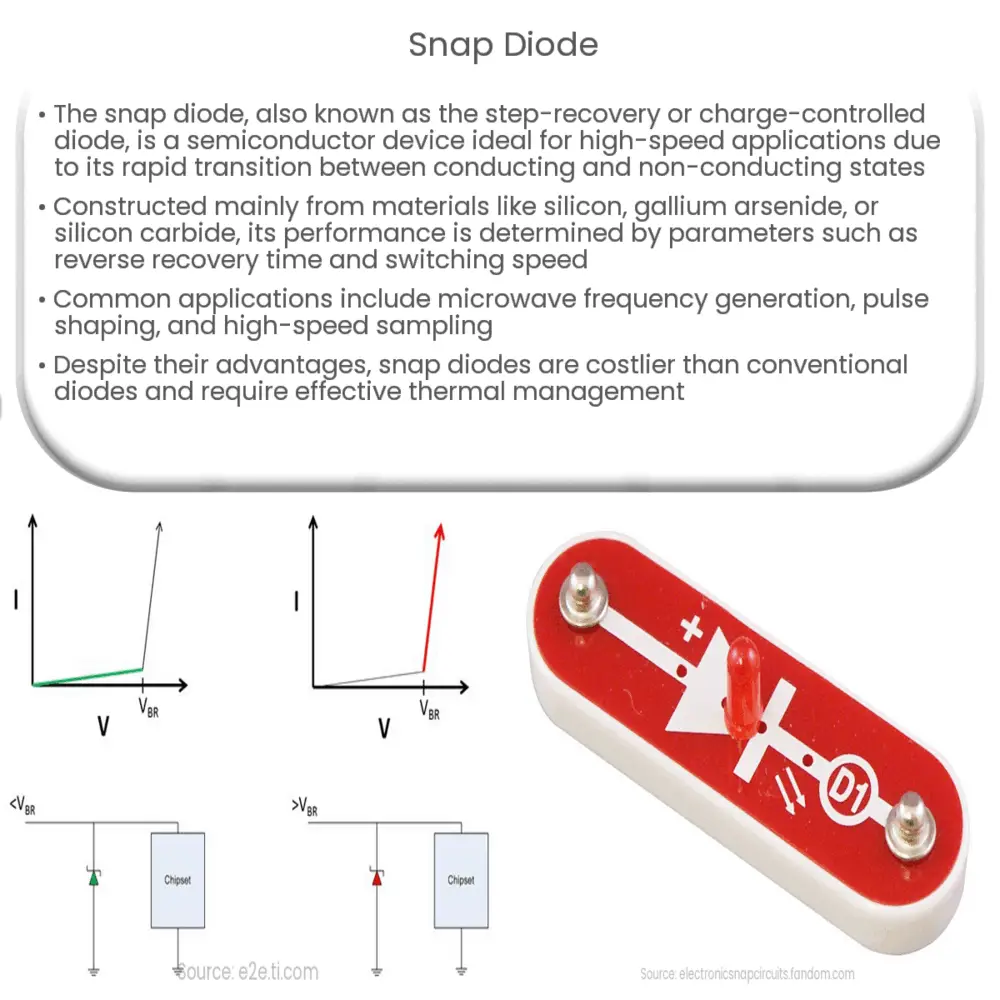A snap diode is a fast-switching semiconductor device used in high-speed applications such as microwave frequency generation and pulse shaping.

Snap Diode: A Comprehensive Introduction
The snap diode, also known as the step-recovery diode or charge-controlled diode, is a unique semiconductor device that finds applications in various fields, such as microwave frequency generation and pulse shaping. This article will provide a comprehensive introduction to the snap diode, its working principle, and its applications.
Working Principle of Snap Diode
The snap diode operates based on the rapid transition from a conducting to a non-conducting state. It exhibits a very sharp reverse recovery characteristic, making it an ideal choice for high-speed applications. When the diode is forward-biased, the charge carriers (electrons and holes) are injected into the device, resulting in a current flow. Once the voltage across the diode is reversed, the charge carriers are quickly extracted from the device, causing the current to drop rapidly to zero. This abrupt change in current is the defining characteristic of the snap diode.
Construction and Materials
Snap diodes are typically constructed using materials such as silicon, gallium arsenide (GaAs), or silicon carbide (SiC). The choice of material is crucial in determining the diode’s performance characteristics, such as its operating frequency range and switching speed. Silicon-based snap diodes are the most common, offering a balance between cost, performance, and reliability. GaAs and SiC-based diodes, on the other hand, provide higher performance at the expense of increased cost and complexity in manufacturing.
Key Parameters of Snap Diodes
Several key parameters determine the performance of a snap diode in a given application. These parameters include:
- Reverse Recovery Time (trr): This is the time required for the diode to transition from the conducting to the non-conducting state. Shorter reverse recovery times result in faster switching speeds, making the diode suitable for high-speed applications.
- Forward Voltage (Vf): This is the voltage drop across the diode when it is in the conducting state. Lower forward voltages lead to higher efficiency in the circuit, as less power is dissipated as heat.
- Reverse Breakdown Voltage (Vbr): This is the maximum reverse voltage the diode can withstand without undergoing irreversible damage. Higher reverse breakdown voltages allow the diode to operate safely in high-voltage applications.
- Switching Speed: This is the rate at which the diode can transition between its conducting and non-conducting states. Higher switching speeds enable the diode to be used in high-frequency applications.
Applications of Snap Diodes
Snap diodes find applications in various fields due to their unique properties. Some common uses include:
- Microwave Frequency Generation: Snap diodes can be used in microwave frequency multipliers, where their rapid switching capabilities enable the generation of high-frequency signals with minimal distortion.
- Pulse Shaping: The sharp reverse recovery characteristic of snap diodes allows them to be used in pulse-shaping circuits for generating fast-rise-time pulses.
Sampling and Detection:
Snap diodes are used in high-speed sampling and detection circuits, such as those found in digital oscilloscopes and communication systems. Their fast switching characteristics enable accurate sampling of high-frequency signals, ensuring minimal distortion and signal integrity.
Impedance Matching:
Due to their rapid transition from low to high impedance states, snap diodes can be used in impedance matching networks. This allows for the efficient transfer of energy between different stages of a circuit, minimizing losses and improving overall system performance.
Advantages and Disadvantages of Snap Diodes
Like any other electronic component, snap diodes have their advantages and disadvantages:
Advantages:
- Fast Switching Speed: Snap diodes are known for their rapid transition between conducting and non-conducting states, making them ideal for high-speed and high-frequency applications.
- Low Distortion: The sharp reverse recovery characteristic of snap diodes ensures minimal distortion of signals, making them suitable for applications where signal integrity is crucial.
- Compact Size: Snap diodes are relatively small in size, allowing them to be easily integrated into compact electronic devices and systems.
Disadvantages:
- Higher Cost: Compared to conventional diodes, snap diodes are generally more expensive due to the specialized materials and manufacturing processes involved.
- Thermal Management: Due to their fast switching speeds, snap diodes may generate significant amounts of heat, requiring careful thermal management to ensure reliable operation and prevent damage to the device.
Conclusion
In summary, snap diodes are unique semiconductor devices that offer fast switching speeds and low distortion, making them ideal for a wide range of high-speed and high-frequency applications. Despite their higher cost and thermal management challenges, snap diodes continue to be an essential component in various fields, such as microwave frequency generation, pulse shaping, sampling, detection, and impedance matching. Understanding their working principle, key parameters, and applications can help engineers and designers select the appropriate snap diode for their specific requirements, ensuring optimal performance and efficiency.

